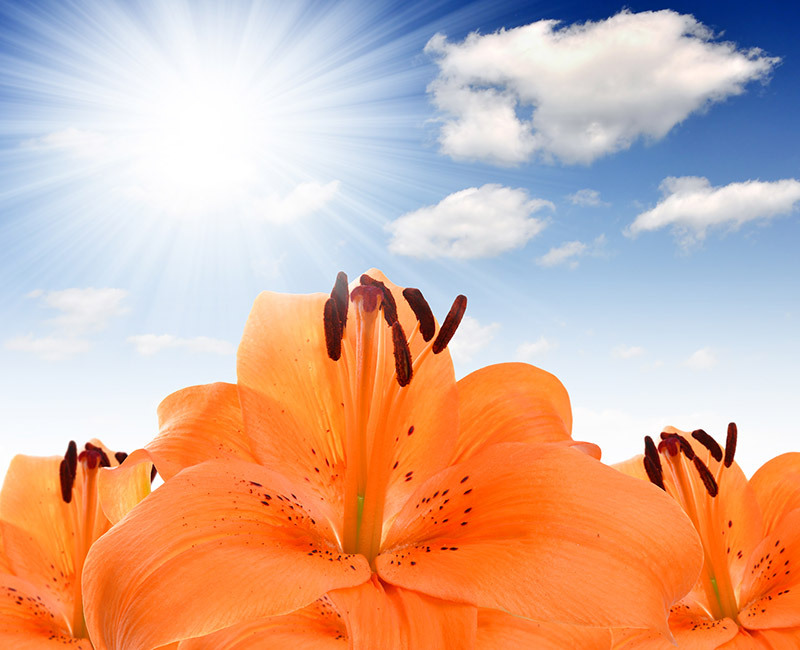8 Lesser-Known Sunflower Facts That Will Intrigue You
Posted on 25/08/2025
8 Lesser-Known Sunflower Facts That Will Intrigue You
Sunflowers are more than just cheerful blooms that track the sun across the sky. With their vibrant yellow petals and characteristic large heads, these flowers often symbolize warmth and adoration. But did you know sunflowers hide a trove of fascinating secrets that go far beyond their radiant appearance? In this comprehensive article, we'll unveil 8 lesser-known sunflower facts that will intrigue even the most ardent nature lovers and gardeners. Whether you're seeking sunflower trivia or want to dig deeper into the science and symbolism behind these botanical wonders, read on to uncover new layers behind one of the world's most beloved flowers.
1. Sunflowers Originate from North America
When you envision fields of sunflowers, you might picture idyllic European landscapes. However, sunflowers (Helianthus annuus) have their roots firmly planted in North America. Archaeological studies reveal that indigenous peoples cultivated sunflowers as early as 3,000 BCE, using them for food, oil, and even medicinal purposes. Later, Spanish explorers brought sunflower seeds back to Europe, where the flower's popularity soared.
- Native Habitat: Sunflowers naturally thrived in the prairies and open fields of present-day United States and Mexico.
- Diverse Uses: Indigenous tribes ground sunflower seeds for flour, extracted oil, and even dyed fabrics using sunflower pigments.
- Global Spread: From Russia to China, sunflowers quickly became a staple crop across the world.
Next time you admire a sunflower's golden face, remember it was once a staple of ancient American civilizations!

2. Sunflowers Exhibit Heliotropism Only While Young
It's a common belief that all sunflowers face and follow the sun throughout their lives. However, heliotropism--the movement of plants in response to sunlight--is mainly observed in young sunflower plants. Mature sunflowers typically remain oriented toward the east. This adaptation maximizes early-morning warmth, which helps attract pollinators like bees by ensuring the flower heads are warmer and more inviting.
- Seedling Stage: The flower buds and leaves actively track the sun from east to west during the day, then reset to face east by sunrise.
- Fixing East: Upon blooming, sunflowers "lock" into an eastward direction, likely due to growth hormones and stem hardening.
- Pollinator Attraction: Facing east accelerates morning warming, which attracts more pollinators and increases seed production.
Heliotropism in sunflowers is a stunning example of how plant physiology adapts for survival and pollination success.
3. Sunflowers Are Masters of Phytoremediation
Sunflowers do much more than beautify gardens--they can also heal the earth. In a process called phytoremediation, sunflowers are used to draw toxins such as lead, arsenic, and uranium from contaminated soils. This natural cleanup ability was harnessed following events like the Chernobyl nuclear disaster, where vast fields of sunflowers helped remediate radioactive sites.
How Does Sunflower Phytoremediation Work?
- Absorption: Sunflowers absorb toxic heavy metals through their roots, effectively removing them from the soil.
- Safe Disposal: The contaminated plants are then harvested and safely discarded or processed.
- Effective Range: Studies demonstrate sunflowers can reduce soil toxicity in relatively short periods, especially for heavy metals.
These hardy blooms are environmental heroes, making sunflowers an integral tool in green remediation technology worldwide.
4. A Sunflower Is Not Just One Flower
Observing a sunflower head, you might think you're looking at a single, enormous blossom. In truth, each sunflower "flower" is made up of thousands of tiny flowers, or florets. The large yellow "petals" are actually ray florets, while the center is composed of disk florets. Each disk floret can develop into a seed, highlighting the sunflower's ingenious reproductive design.
- Ray Florets: The outer, petal-like structures attract pollinators.
- Disk Florets: The central spirals contain the reproductive organs and are where seeds develop.
- Seed Patterns: The florets are arranged in a mathematical spiral, following the Fibonacci sequence for maximum efficiency.
Sunflowers showcase the beauty of nature's mathematics, blending functionality with aesthetic perfection.
5. There Are Over 70 Varieties of Sunflowers
Think all sunflowers are tall and yellow? Think again! The Helianthus genus includes more than 70 species, and countless cultivated varieties, exhibiting dazzling diversity in size, shape, and color. From petite ornamentals to mammoth giants, sunflowers can surprise even the most experienced gardener.
Diverse Sunflower Types Include:
- Traditional Giant Sunflowers: Such as 'Russian Giant,' reaching 12 feet or more in height.
- Colored Sunflowers: Hybrids like 'Moulin Rouge' and 'Autumn Beauty' showcase rich reds, bronzes, and burgundy hues.
- Dwarf and Pollen-Free: Ideal for borders or bouquets, some cultivars remain under 2 feet tall and are pollenless for allergy sufferers.
- Perennial Sunflowers: Species like Helianthus maximiliani and Helianthus tuberosus (Jerusalem artichoke) return year after year.
Sunflower enthusiasts can choose from a rainbow of cultivars to suit any landscape, vase, or culinary use!
6. Sunflower Seeds: A Compact Nutritional Powerhouse
Sunflower seeds are a popular snack around the world--but their impressive nutritional value is often underestimated. These small seeds, found packed in the heart of the sunflower, are a rich source of healthy fats, plant-based protein, vitamins, and minerals.
- Rich in Healthy Fats: Especially polyunsaturated fatty acids and Vitamin E, which are beneficial for heart and skin health.
- Plant Protein: A single serving of sunflower seeds can offer a significant dose of daily required protein.
- Essential Minerals: Including magnesium, selenium, iron, and zinc.
- Versatile Uses: Sunflower seeds are enjoyed raw, roasted, or pressed into high-quality sunflower oil for cooking and dressings.
Consuming sunflower seeds supports a healthy lifestyle and offers an eco-friendly alternative to animal-based snacks.
7. Sunflowers Have Remarkable Cultural and Symbolic Meanings
Throughout history, sunflowers have held deep symbolic significance in cultures worldwide. In Native American traditions, the sunflower is a symbol of harvest, bounty, and provision. During the 18th century in Europe, sunflowers became associated with loyalty and constancy because of their sun-tracking behavior (heliotropism).
Modern Sunflower Symbolism Includes:
- Happiness & Positivity: Their bright coloration and sun-facing orientation uplift spirits and symbolize optimism.
- Peace & Anti-Nuclear Messages: Sunflowers became a strong peace symbol in the late 20th century, especially linked to nuclear disarmament campaigns.
- Artistic Inspiration: From Van Gogh's iconic "Sunflowers" series to the motifs in home decor, these blooms are cherished for their artistic and decorative appeal.
The sunflower's meaningful blend of beauty, endurance, and resilience continues to enchant people across the globe.
8. Sunflowers Influence Local Biodiversity
Did you know growing sunflowers can have a positive impact on your local ecosystem? These flowers serve as a crucial food source and habitat for a wide spectrum of pollinators, birds, and other wildlife.
- Bee Magnet: Sunflower nectar and pollen attract dozens of species of bees and beneficial insects.
- Bird Buffet: As the seeds mature, finches, chickadees, and butterflies flock to feast.
- Pest Control: By drawing in beneficial insects, sunflowers can help manage garden pests naturally.
- Soil Improvement: Their deep roots aerate and enrich the soil, supporting future crops.
Adding a sunflower patch to your garden doesn't just add beauty--it enhances the entire landscape's health and diversity.

Bonus Fact: Sunflowers Are Used in Art and Industry
From Van Gogh's masterpieces to modern sustainable industries, sunflowers make enduring contributions beyond the garden. Sunflower oil is a major cooking staple globally, valued for its high smoke point and light flavor. Sunflower fibers are used in eco-friendly textiles, while sunflower byproducts fuel the production of biodiesel and animal feed.
- Art: Sunflowers have been muses for painters, sculptors, and photographers worldwide.
- Eco Products: Sustainable biomaterials such as biodegradable pots and packaging are now made from sunflower hulls and stems.
- Renewable Energy: Sunflower oil seeds are converted into biofuel, supporting green energy initiatives.
Sunflowers: Nature's Golden Marvels
With their stunning appearance and multi-faceted benefits, sunflowers are truly one of nature's most remarkable creations. Whether you are drawn to their historical origins, scientific intricacies, ecological impact, or nutritional power, there's much more to these blooms than meets the eye.
Recap: 8 Intriguing Sunflower Facts
- Their true home is North America.
- Young plants track the sun--adults face east.
- Sunflowers are natural soil cleansers.
- Each "flower" is actually thousands of tiny blooms.
- Sunflowers come in a wide range of varieties and colors.
- The seeds are nutritional dynamos.
- Cultural meaning goes far beyond their sunny looks.
- Sunflowers enhance garden biodiversity and ecosystem health.
If you're looking to enrich your garden, pantry, or knowledge base, sunflowers are an endlessly fascinating and rewarding choice. Try planting some today and experience the wonders firsthand--or simply admire these sun-bright blooms from afar, knowing their history is as rich and radiant as their color.
Looking for more surprising plant facts and gardening tips? Bookmark this site or subscribe to our newsletter for weekly nature insights and flower stories!
Latest Posts
Insider Tips on Extending Your Poinsettias' Bloom
Expose 3 easy-to-follow methods for preserving your cherished blooms
8 Lesser-Known Sunflower Facts That Will Intrigue You






